This was written by the guest writer, Jasmin
Saviours, Angels, Robots, Nuns and Vampires!
After my look at the ties of Dao, Onmyōji and Twin Star Exorcists, in this installment of my ‘influenced by’-series I’ll engage with an exotic topic – for Japan, that is. Let’s have a look at Christianity in Japan and its appearances in Anime!
Saint Young Men
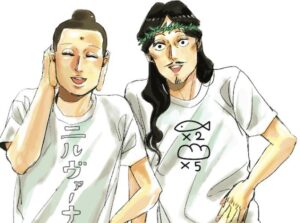
A special favourite of mine, often overlooked, is the manga (by Nakamura Hikaru, 2006-now) and anime film Saint Young Men (Seinto Oniisan, 2013), which humourusly portrays the day-to-day experiences of best buddies Buddha and Jesus on their vacation in Japan. This usually entails accidental miracles and the trouble the two of them have to (a) maintain their incognito and (b) cope with modern life.
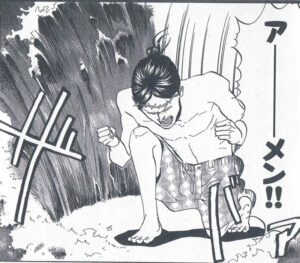
In one instance, Buddha takes Jesus to a swimming pool and Jesus has to admit he is somewhat afraid of water, hence his preference to walk across. Buddha persuades him to try and dive. When he eventually does, well… Let’s just say the Egyptians have seen it before.
However, anime with religious allusions or symbolism don’t usually feature a religious figure as a character. Instead, there tends to be a mashup of names, symbols, and stories, or just playing on “cool” exotic themes. The stories, it seems are not as popular as the images.
So, how did Christian lore arrive in Japan in the first place?
The introduction of Christianity to Japan
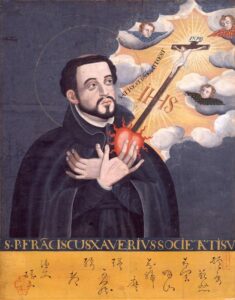
The Portuguese “discovered” the Japanese archipelago in 1542. (From a European point of view. The Chinese, Koreans, and of cause the Japanese themselves had known for centuries that it existed.) Seven years later, Jesuit missionary Francis Xavier and his subordinates landed in what is now Nagasaki prefecture, on the island of Kyūshū, and introduced the Japanese to Christianity.[i] Initially, the new religion received a warm welcome.
Early Success
At first, Japanese audiences took Christianity for just another sect of Buddhism. Early translations of Christian scripture into Japanese rendered “God” as “Dainichi Nyōrai”, thereby equating him with the Great Sun-Buddha, a central deity of esoteric Buddhism. (In Japan, Dainichi Nyōrai is also associated with Amaterasu, goddess of the sun and ruler of the heavens in Shintō.) This translation intensified general similarities in Christian and Buddhist ethics. It also catered to the Japanese syncretistic worldview, which easily blends different religions according to individual spiritual needs. Therefore, the new religion was not met with resistance. It was seen as an addition, not a replacement, of the old ones. Statistics also play a role here: If a regional ruler converted, his subjects would follow, thus one conversion could bring a significant rise in the number of “believers”.
But most important was the current political landscape. Christianity arrived in Japan at a time of internal struggle. It was end of the Warring States Period (Sengoku Jidai) and military leader Oda Nobunaga was trying to unify Japan. Among other things, he fought the political influence of Buddhist monasteries and eventually burnt down most of Enryakuji temple on Mt. Hiei, from where the monks had brought their demands to the imperial capital of Kyōto. In this context, Oda encouraged the spread of Christianity as a rival to Buddhism.[ii]
Persecution
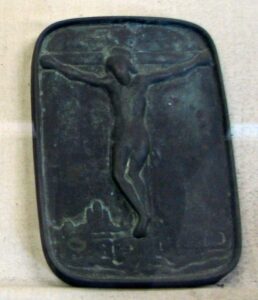
The official view of Christianity turned, however, due to several developments. Firstly, the Christian idea of superiority over all other beliefs conflicted with the aforementioned syncretistic approach of Japanese Buddhism and Shintō. Secondly, the newly established military government was concerned about Catholics’ loyalty to the pope. Thirdly, news of the confessional wars between Catholics and Protestants in Europe sparked concern of similar things happening between converts of the two sects in Japan.
As a result, missionary action and the performance of Christian belief in Japan was increasingly persecuted, culminating in the violent suppression of the Christian peasant uprisings of Amakusa and Shimabara in 1637. [iii] Three years later, Japan entered its over 200-year isolation (sakoku), until the ships of American commodore Perry forced the opening of trading ports in the mid-19th century. Christian belief only survived in secret among the so-called “hidden Christians” (kakure kirishitan). Buddhist images served as disguises for the forbidden worship; for example, the bodhisattva Kannon is often depicted as female, in some cases even with a child, and can therefore double as Virgin Mary.[iv]
Return
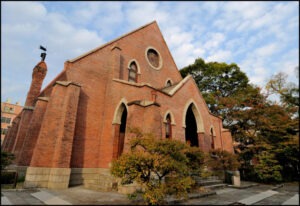
After the Meiji Restoration (1868) Japan denounced its isolation and rapidly imported European philosophy and science. The new imperial government encouraged everything which seemed to further the modernization of the country. In this context, they eventually lifted the ban on Christianity, but soon grew hostile again. Like Buddhism, the religion of Christianity stood against the proposed doctrine of State Shintō and seemed in conflict with the new, modern, scientific worldview.[v] However, the establishment of Christian universities such as Kyōto’s Protestant Dōshisha University (1875) and Tōkyō’s Catholic Sophia University (1911) demonstrates the influence of Christianity on Japanese higher education. In this way, Christianity was an important factor in the political developments leading to modern Japan.[vi]
Since the American occupation after WWII, the Japanese have also adopted many aspects of Western Christian culture, such as Christmas and Christian wedding ceremonies. However, only 1-3% of the Japanese population count themselves as Christian.[vii] Thus these rituals are decontextualized and secularized, perhaps a part of global consumer culture. (Which, arguably, is also what they have become in “Christian” countries.) As a part of this global consumer culture, popular culture emerges as a space of cultural interaction and engagement with myth.
Neon Genesis Evangelion

Ten years ago, Neon Genesis Evangelion (Shinseiki Evangerion) would not have needed an introduction among anime fans. The anime series (produced by studio Gainax and directed by Anno Hideaki) ran in 1995-6 on TV Tokyo and reached international audiences from 2000 onward.[viii] Anime scholar Susan Napier lauds it as a landmark series, both as a representative of its genres – science fiction and, more specifically mecha anime – and because of its enormous popularity and impact on popular culture.[ix] For more information on NGE’s outstanding contributions to anime storytelling from this site’s main author, see this post. The effect lingers; you could still see some Evangelion cosplay at German Anime-Conventions in 2012 (which is when I stopped going) and we found figurines of its characters in UFO-Catchers in Kyōto only last year. So I’ll keep the summary brief.
What happens?
In a dystopian mechanized future, the world (i.e. mostly Japan, i.e. mainly Tokyo) is threatened by aliens, the ‘angels’. The only ones who can defeat them are certain 14-year-olds, when they become pilots of giant robots called Evangelions (EVA for short). The main protagonist is one of these pilots, Ikari Shinji, a sulky boy in conflict with his estranged father, who happens to run the operations against the aliens. One would expect a generic “boy hero overcomes obstacles and saves world with his friends” story, as the opening theme[x] suggests, but this is what NGE refuses to do.
Instead, it depicts the psychological issues of its main character(s) and embellishes the “humans fight aliens” plot with so many references to Judeo-Christian lore that researchers have interpreted the work as a) a postmodern deconstruction of reality and identity b) criticism of consumer culture and America-centered political history and c) a contemplation of the meaning of life – and that’s just the three articles I found in my university library.[xi]
What’s Christian?
Much of the stories NGE draws on are not Christian as much as based on Hebrew Kabbala and the Gnostics.[xii] The title ‘Evangelion’ itself refers to the gospel, of course. Because the antagonistic aliens are called angels, on can already assume that humanity has, in some way, angered God and brought these events upon itself? Well, what exactly the root cause of everything is, the series never reveals, but it becomes clear that at least the cataclysmic events around the first angel, Adam, were caused by human arrogance and ‘it attempting to play God’.
Old and New Testament, and far beyond that

In addition, with the first angel named Adam, it surely comes as no surprise that the robots called EVAs have a certain connection to it (i.e. they are partially constructed after his model), or that another angel by the name of Lilith appears.[xiii] Speaking of angels: the Japanese dub uses shito, which would be more closely translated as ‘apostle’, although both refer to a divine/religious messenger.[xiv] For more of the Old-testament-based references, I refer you to Ortega’s elaborate analysis (see Notes section below).
Concerning the New Testament, we have firstly the three computer brains of the NERV Corporation, which take their names from the three wise men of the nativity story: Caspar, Melchior, and Balthasar.[xv] Secondly, the ultimate weapon against angels is the Lance of Longinus (traditionally, the weapon thrust into the body of Christ on the cross to check if he was dead). The series queers this artifact’s story, however, because the crucified form we first see the lance stuck in is the angel Lilith. Thirdly, since Shinji is expected to save the world, we might see him as a Christ figure suffering for humanity’s sake. Fittingly, hints of his mother associate the Madonna.[xvi] Fourthly, the cross features repeatedly, not just as a pendant Misato wears – the explosion of a dying angel is cross-shaped. Finally, the secret organization which controls all events is called SEELE, German for ‘soul’.
Instant Confusion, Just Add Myth
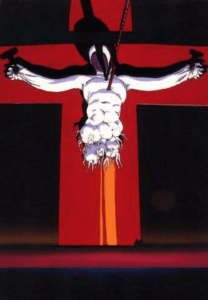
I’d like to emphasize an aspect Ortega overlooks: the intense blending of stories and images. Traditionally, angels are beings of a different order than humans: stronger, more beautiful, servants of God, but without free will. While NGE retains the power aspect, it also strongly implies that humans and angels are very closely related (i.e. humans, angels, and EVAs are all in some way decedents of Adam and/or Lilith).
In a similar vein, the ‘original’ Lance of Longinus has nothing to do with angels, Adam, or Lilith. NGE plays on the association that it is a God-killer weapon, but then again, angels are not God, are they? This anime is so confusing… Anyways, this “take what you need and apply it to your problem/story”-approach resembles the syncretistic view of religion I discussed earlier.
Another aspect I find interesting is the interlacing of religious myth and science fiction, or the myth of technology. You know, giant robots, clones and bioengineering, supercomputers, and the like. A similar connection between religion and science marks the second work I’d like to discuss here.
Trinity Blood
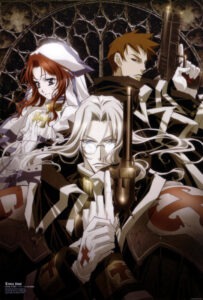
One story migrating and evolving from one medium to the next is typical for Japanese popular culture, as I mentioned before. Trinity Blood began in 1999 as a light novel series by Yoshida Sunao, spawned a shōjo manga (2004) and an anime adaptation (2005). This leads to a noticeable shift in art styles; it also produces conflicting information, differing plot lines and character developments, and so on. The anime is probably best known, but the novels provide most background information… and I’ve mainly read the manga 😉 But the interesting parts are common to all versions.
What happens?
1000 years after devastating war, two intelligent species live an Earth: humans (Terrans), and vampires (Methuselah). Human military and political power is concentrated at the Vatican, whereas Byzantium has become the vampire capital. Both powers are in a Cold War-type of setting, and “lost technologies” from before Armageddon greatly impact the balance of power.
For secret missions, usually concerning vampires, the Vatican sends out special agents. One of those is the main protagonist, Abel Nightroad. In Istvan (Bulgaria), Abel and his partner Tres cross paths with Sister Esther Blanchett, and political complications ensue. Despite his ditzy appearance, Abel is an immensely powerful fighter thanks to the “Crusnik” nanomachines in his body: As vampires prey on humans, Crusnik prey on vampires. Later the story reveals the origin of both vampires and Crusnik: Vampires are humans infected with the Kudlak Bacillus, which in turn served as food for the Crusnik nanomachines, both of which were discovered in a crashed alien spaceship when humanity tried to colonize Mars.[xvii]
What’s Christian?


Whereas NGE intensely appropriates stories and symbols, Trinity Blood makes pronounced use of Christian institutions, that is, the hierarchy and insignia of the Catholic Church. Abel is introduced as a priest, Esther as a (novice) nun, and higher positions are occupied by bishops such as Esther’s mother figure Laura and cardinals such as Abel’s supervisor Catharina Sforza. The character’s clothing is visibly inspired by actual nun’s habits, priests’ and cardinal’s clothing, though the artist(s) also take considerable liberties. Esther’s blue-trimmed white habit evokes that of Mother Teresa, though I couldn’t find any habit design with a short, folded back part of the veil like the one Esther’s wearing. Dressing priests in black and cardinals in red also fits the Church hierarchy. Take this image of Caterina as an example. There’s a lot of detail added, such as cuffs, armour, embroidery etc., but the basic shape is still there – notice the short cloak-like part around the shoulders. I don’t know where the hat came from, through… perhaps the artist just likes big hats 😉. And of course, crosses and rosaries and the like abound as decorative elements.
Political involvement
Christian belief plays a role as well, though mostly as a tool of political power, not a feature of the main character’s personality. Thus, Esther is declared a Saint in a context of political intrigue, in order to affect the pious population. Christian charity features briefly in the beginning as part of the description of the convent in Istvan. However, there is no special promotion of Christian values by main characters, although most of them are members of the Church. Similarly, while the series features numerous terrorists or vigilantes of human or vampire origin, their motivation is usually personal, nationalist or racist, not religious. The series carefully subverts black-and-white morality judgements and shows its characters’ motivations to be diverse, personal, and (Terran or Methuselah) very human.
Names
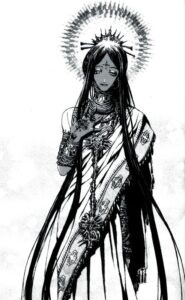
The characters refer to the Earth-encompassing war which led to the present state of affairs as Armageddon, but it is unclear if this is a reference to the Book of Revelation or just popular culture, where both “Armageddon” and “apocalypse” are used to describe large-scale catastrophes capable of exterminating humanity.
Like NGE, Trinity Blood references Genesis and the first humans, but goes one generation further. The first Crusnik is Cain, followed by Abel (the main Character) and their sister Seth. In the Bible, Seth was the third son of Adam and Eve, born after Cain had slain Abel. The fourth Crusnik bears the name Lilith. She is the eldest of these four – all genetically engineered for a Mars colonization project. Interestingly, Lilith becomes a Crusnik last, and only to protect humanity from the other three. This is a weird echo of the NGE moment when humanity is collectively, as “Lilim” or Lilith’s offspring, indicated to be the final, the 18th angel. In both cases, Lilith is associated with humanity, whereas in the source material, Lilith is punished by God for insubordination and becomes a mother of demons. Trinity Blood, by contrast, shows her as a saint-like figure.
Concluding remarks
When it comes to the use of Christian content in anime, the primary appeal probably lies in its exoticism. Whereas with Twin Star Exorcists the animators could assume at least a vague familiarity with the religious associations among their audience, Christianity is both relatively new and relatively rare in Japan. Its visual cues (churches and clothing, like the bride’s white dress) are probably more familiar to the audience then any narratives. Except of course prior adaptations of the same source material. Thus interaction with Christianity might be more external, as in Trinity Blood, adapting the institutions and clothes to contribute to the work’s exotic European flavor. Or it may delve into complex, multilayered and contradictory myth-building, as NGE does. One reviewer of the latter points out that the mere inclusion of religious imagery can both add a cool factor and give a work a feeling of depth and gravitas.[xviii]
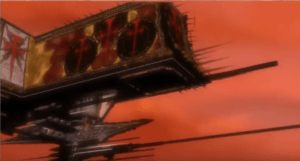
The creative blending of diverse types of stories may, as I mentioned above, be linked to the syncretistic tradition in Japanese religion. In this vein, the connection of Christian elements and Science Fiction makes me wonder if there is some historic precedent as well. Was European science and ‘modernity’, as imported after the Meiji Restoration, seen as somehow connected to European history of thought?
At least in the beginning, this seems to have been true: “It should be remembered that Christianity was introduced to Japan after it had already been well refined in Western society and was arrayed in the garb of modern religion. At the beginning the Japanese people even thought that modernization, Westernization, and Christianization were one and the same thing.”[xix] Perhaps, some residue of this conflation still remains?
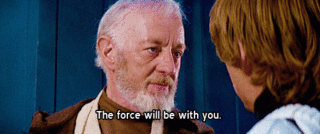
Notes and References:
[i] See http://www.nippon.com/en/features/c02303/ for a biographic account of these early missionaries and (on page 2) pictures of Japanese churches.
[ii] Bunce, William. Religions in Japan. Rutland & Tōkyō: Charles E. Tuttle, 1948. 20-21. See also: Covell, Stephen. “Religious Culture”. In: Sugimoto, Yoshino (ed). The Cambridge Companion to Modern Japanese Culture. Cambridge University Press, 2009. 147-8.
[iii] Bunce 1948:21-22, 150; Covell 2009:148-9.
[iv] http://www.onmarkproductions.com/html/maria-kannon.html
[v] Bunce 1948: 151-3, Covell 2009:149.
[vi] Ellington, Lucien. Asia in Focus: Japan. Santa Barbara & Oxford: ABC Clio, 2009. 165.
[vii] Covell 2009:150.
[viii] Both the American and German versions were apparently first broadcast in 2000; but I have to trust Wikipedia on this since TV-schedules prove quite difficult to research.
[ix] Napier, Susan. “When the Machines Stop: Fantasy, Reality and Terminal Identity in Neon Genesis Evangelion and Serial Experiments Lain”. In: Bolton, Christopher; Csicsery-Ronay, Istvan Jr; & Takayuki Tatsumi (eds). Robot Ghosts and Wired Dreams: Japanese Science Fiction from Origins to Anime. University of Minnesota Press, 2007. 108.
[x] https://www.youtube.com/watch?v=jYZfeY8Vg0E, notably the lyrics say „shōnen wa, shinwa ni nare”, “Boy, become a legend”.
[xi] 1) Napier 2007; 2) Redmond, Dennis. „Anime and East Asian Culture: Neon Genesis Evangelion“. In: Allen, Matthew, & Sakamoto, Ruby (eds). Japanese Popular Culture: Critical Concepts in Asian Studies. Volume II: Japanese Popular Culture in the Twenty-First Century. London & New York: Routledge, 2014; 3) Ortega, Mariana. „My Father, He Killed Me; My Mother, She Ate Me: Self, Desire, Engendering, and the Mother in Neon Genesis Evangelion.“In: Mechademia, Vol.2 (Networks of Desire), 2007.
[xii] Ortega 2007.
[xiii] Ortega 2007:218-9.
[xiv] https://wiki.evageeks.org/Angels
[xv] Ortega 2007:223.
[xvi] Ortega 2007:224.
[xvii] http://trinityblood.wikia.com/wiki/Methuselah
[xviii] https://www.youtube.com/watch?v=UiUs6YuSloM
[xix] Kishimoto Hideo, „The problem of religion and modernization in Japan“, p.12. https://nirc.nanzan-u.ac.jp/nfile/3240
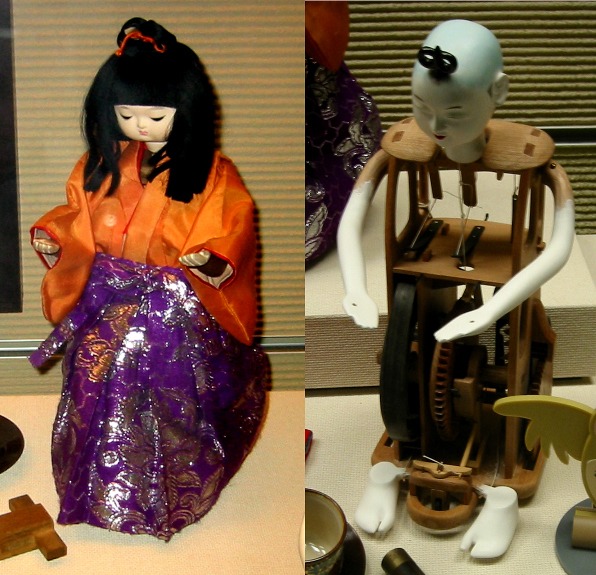
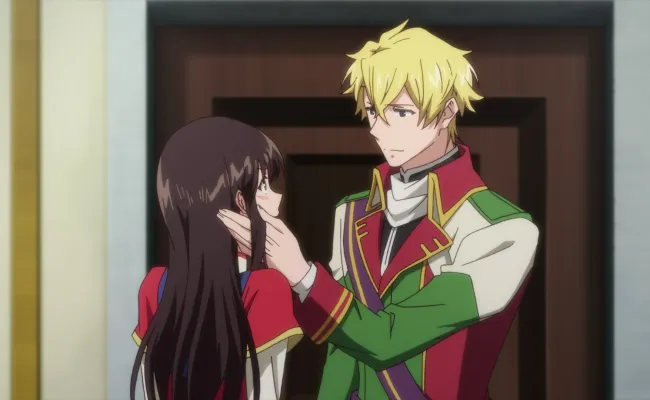
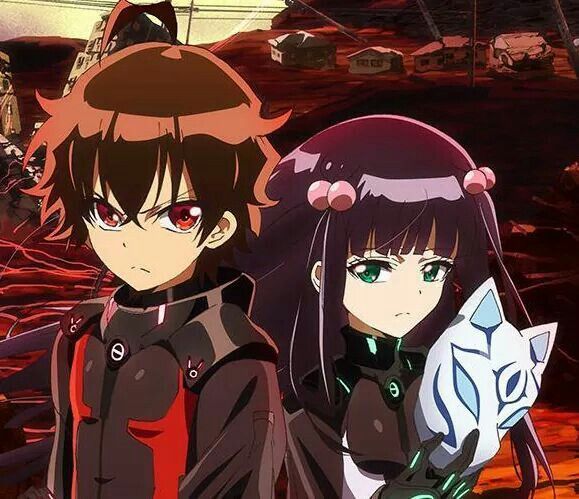

Fascinating. I’ve long been of the opinion that there’s a strongly syncretic relationship between at least many Mahayana forms of Buddhism and Christianity. Having grown up in a Jōdo Shinshū home, but among several Catholic friends , it always seemed there were a surprising number of similarities.
Ashoka’s propagation of the Buddhist Dhamma via trade routes with the Greeks around 250BCE (Maharakkhita), and then the same by Menander about a century later, likely initiated the emergence of the various “savior” religions within the Western traditions. And these would have included both Manichaeism and Christianity, which then rebounded back into the east over the following centuries. So it doesn’t surprise me that Christianity was so easily able to flourish within Japanese culture.
The only big difference (and cultural incompatibility) between them is in an authoritarian versus existential approach to faith. In the West, faith guides an individual’s actions (morality). In the East, proper action within one’s circumstance is reconciled in beliefs (ethic). I think the one (overt) Japanese experiment with the Western approach was among the Ikkō-ikki in the 15th-16th centuries… which didn’t go over well. Ironically, however, Jōdo Shinshū is what survives.
Jasmin did a good job researching for this article. Have you seen the branch of Buddhism/Christianity that merged in remote areas between the Middle East and China? I’m uncertain of the official name of the merge, but Christian tradition links the religion with the Apostle Thomas. The statues of Buddha/Jesus are fascinating with their mix of East and West.
Some, rather forgotten, branches of Christianity take a more Eastern approach to ethics, such as Aryanism (not to be confused with Nazi Aryanism), without the authoritarian perspective. Sadly, centralization and its efficiencies won over these branches of “the Way”. Why do you think the Ikkō-ikki met their demise as they did?
The article is indeed very well researched, and I think it makes a cogent argument. I would just take it a step farther and suggest that at least some of the tenets of Mahāyāna Buddhism *prior* to Christianity’s introduction to Japan were Western, if not Christian influenced. Mahāyāna texts are expansive, and much was written down during and after the times of Indo-Hellenistic exchange.
Manichaeism might be what you’re thinking of… a kind of Mesopotamian Gnostic merging of Western and Eastern traditions with “Mani” as the prophet who unites the revelations of Zoroaster, Jesus and Buddha. The tradition expanded eastward through the Indo-Greek territories into China, and was among the world’s most widespread religions by the 5th-century. It survived in parts of China into the 14-century. The Council of Nicaea also left us today with a limited perspective of what types of Christian thought and philosophy might have migrated eastward… Orthodoxy, Arianism, Gnosticism, Gospels of Thomas…?
Exchanges also apparently went both ways by 150BCE… Hebrew ossuaries and spiritual hand gestures appearing in the West at the same time as those obviously Hellenistic Buddhist statuaries in the East. By the time of Jesus, there had already been two centuries of exchange along post Alexander-the-Great, Indo-Greek trade routes, so there were certainly also cultural/religious exchanges… Greco-Buddhism, as well as Hellenistic and Buddhist-influenced Judaism.
With regard to the Ikkō-ikki (一向宗), or the “single-minded school”, they were ostensibly Buddhist. But by adopting a Western-style faith-driven moral code in a sort of “Mark 12:17” manner, they elevated the authority of their faith in the Amida Buddha above that of loyalty to the daimyo. Oda Nobunaga in particular viewed that as nothing less than a militant religious uprising. Ironically, the Ikkō-ikki probably did more to bring about a consolidation of samurai power by providing a common enemy, ultimately benefiting Nobunaga’s successor, Tokugawa Ieyasu.